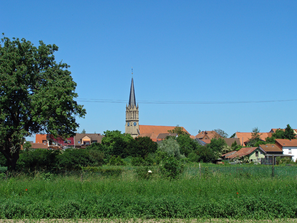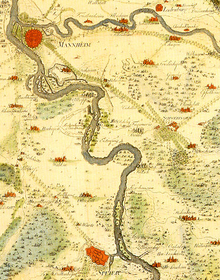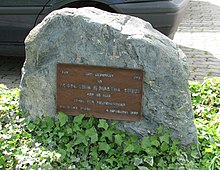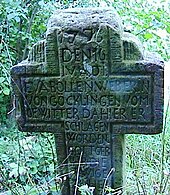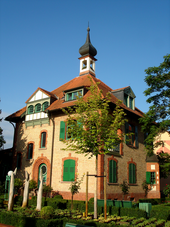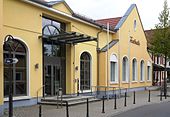Bruehl (Baden)
| coat of arms | Germany map | |
|---|---|---|

|
Coordinates: 49 ° 24 ' N , 8 ° 32' E |
|
| Basic data | ||
| State : | Baden-Württemberg | |
| Administrative region : | Karlsruhe | |
| County : | Rhein-Neckar district | |
| Height : | 102 m above sea level NHN | |
| Area : | 10.19 km 2 | |
| Residents: | 14,288 (Dec. 31, 2018) | |
| Population density : | 1402 inhabitants per km 2 | |
| Postal code : | 68782 | |
| Primaries : | 06202, 06232 (Kollerinsel) |
|
| License plate : | HD | |
| Community key : | 08 2 26 009 | |
| LOCODE : | DE BRU | |
| Community structure: | 2 districts | |
| Address of the municipal administration: |
Hauptstrasse 1 68782 Brühl |
|
| Website : | ||
| Mayor : | Ralf Göck ( SPD ) | |
| Location of the municipality of Brühl in the Rhein-Neckar district | ||
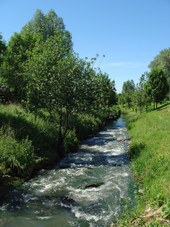
Brühl ( Kurpfälzisch Briehl [ bʁiːl ]) is a municipality in the Rhein-Neckar district in the north-west of Baden-Württemberg . It is part of the Rhine-Neckar metropolitan region , a metropolitan area with over two million inhabitants.
Mentioned for the first time in 1157, Brühl belonged to the Speyer Monastery and the Palatinate for a long time . The former farming and fishing village on the Rhine developed - together with the incorporated district of Rohrhof - after a phase of its own industrial settlements (in particular brickworks, airship construction and aluminum processing) in the 20th century into a suburb of the city of Mannheim bordering to the north . Most of its residents work there. The place name is of Celtic origin and indicates a meadow by the water.
geography
location
The municipality of Brühl consists of the two districts Brühl and Rohrhof . It is located in the northwest of Baden-Württemberg in the center of the Rhine-Neckar region on the border with Rhineland-Palatinate on the Rhine . The 400 hectare Kollerinsel belonging to Brühl , originally a peninsula formed by a loop of the Rhine that was cut after the Rhine was straightened, is - next to the old town of Constance - one of the two areas on the left bank of the Rhine in Baden-Württemberg. Coming from Kraichgau , the Leimbach flows through the local area in an east-west direction and flows into the Rhine.
Brühl borders directly on Mannheim in the north . Schwetzingen is to the east and Ketsch to the south . The Rhineland-Palatinate towns of Altrip , Waldsee and Otterstadt are located to the west of the Koller Island . In addition to Mannheim, three other cities are not far away: Heidelberg ten kilometers east, Speyer eleven kilometers southwest and Ludwigshafen eleven kilometers northwest.
Geology and natural space
The residential development is on a high bank of the Niederterrasse in the Upper Rhine Graben . To the west are the Rhine floodplains , which are several meters lower, and which were formed over the centuries by the changing loops of the Rhine. An extension of the Neckar alluvial cone ends to the east . All three surface forms come from the Quaternary . The gravel formed by sedimentation was dismantled in the 20th century, creating several quarry ponds.
In the north of the river valley there are alluvial loam soils and in the south as well as on the Koller Island there are loam and sand soils, each with acres of up to 86. On the lower terrace around the Leimbach there are sand and loam soils with arable land numbers up to 70. On the sand and gravel areas of the north Moderate diluvial sandy soils prevail on the high ground .
The district enclaves of Schwetzinger Riedwiesen and oven-Riedwiesen located on the Rhine are under nature protection because of their numerous, very different biotopes of great ecological importance . In addition, all other areas of the Rheinaue and the Kollerinsel are designated as landscape protection areas. There is only a narrow strip of riparian forests on the Kollerinsel and to a lesser extent on the opposite side of the Rhine.
The district extends over 1019 hectares. Of this, 30 percent is settlement and traffic area, 48 percent is used for agriculture, 10 percent is water and 9 percent is forested.
climate
65 percent of the climate is determined by the influx of maritime air masses, which is why winds from the west predominate. Thanks to the sheltered location in the Upper Rhine Plain between Haardt in the west and Odenwald in the east, the temperatures are very mild. The closest climate station in Mannheim measured an average temperature of 10.5 degrees Celsius between 1971 and 2000 and an annual rainfall of 668 millimeters. The warmest month is July with an average of 19.9 degrees Celsius, the coldest is January with 1.8 degrees Celsius. Temperatures over 30 degrees Celsius are not uncommon in midsummer. Most of the rainfall occurs in July and the driest month is February.
|
Monthly average temperatures and precipitation for Mannheim 1971–2000
|
history
Place names
The name of Brühl given in traditional documents changed over the course of time from Bruowele via Bruwel, Bruel and Priel to Briel or Briehel (this is how the name is still pronounced in the local dialect today). From the early 18th century, the current variant was already in use, but it wasn't until the early 19th century that it finally became established. The word stands in Middle High German for a fenced in meadow by the water and is of Celtic origin.
Rohrhof was first mentioned in a document as Rorheim and Rohrheim. In the 16th century the name, which stands for Heim im Röhricht , changed to Rohrhof.
Early history
Archaeological finds in the Brühl district point back to the Ice Age . Man-made tools and shards date from the Neolithic Age . However, it is not certain whether the area was really settled or whether the finds were washed up by the Rhine. In 1906 and 1997 graves from the Early Bronze Age were found. There are also several finds from the following historical periods.
In the 1st century the Romans crossed the Rhine and under Emperor Vespasian (69–79) the Rhine-Neckar area on the right bank of the Rhine was incorporated into the Roman Empire . Several Roman roads were laid out in the Brühl area. In a north-south direction there was a connection from Ladenburg via Brühl to Schwetzingen and further through the Hardtwald . No archaeological finds, but there are written references to a trunk road on the right bank of the Rhine from Italy to Britain. Both were cut by the West-Ost-Straße from Altrip over the Rhine to Rohrhof and Wiesloch. On the latter there was a Roman wooden watchtower on a hill near Rohrhof. The Romans were pushed back by the great migration in the 4th century.
History from Rohrhof to incorporation
In a document from the year 976 - on the occasion of a gift from Emperor Otto II to the Bishop of Worms - Rohrhof is mentioned for the first time as "Rorheim". The ending -heim indicates a foundation during the Frankish conquest . From the 11th century fiefdoms were the Counts of Henneberg . In 1152 the Bishop of Worms donated the place to the Cistercian Monastery of Schönau , which transformed the settlement into a grangie , that is, most of the houses were demolished and the farmland was cultivated from a large farm yard. The Schönau monastery was the house monastery of the Count Palatine near the Rhine . As part of the Reformation , the monastery was abolished by Elector Ottheinrich in 1558 and the farm and the land were from then on leased by the Care Schönau , initially as a whole, later in quarters or eighths. Until its incorporation in 1878, the court then shared the history of Brühl.
History of Brühl
The first mention of Brühl as "Bruowele" comes from a document from 1157, which states that the Bishop of Speyer Günther von Henneberg acquired Brühl with his private fortune and handed it over to the Speyer Monastery. The exact ownership and rule up to the 15th century are unclear. Property or rights in Brühl were held by the barons of Wiesloch, the Maulbronn monastery , the lords of Handschuhsheim , the nobles of Sickingen and the lords of Helmstatt , among others . In 1423 Hans von Helmstatt sold his quarter to Brühl to Elector Ludwig von der Pfalz. Since then, the place has had two sovereigns : Speyer and the Electoral Palatinate .
In 1405 the Lords of Handschuhsheim held the three Speyer quarters as fiefs; In the 16th century they also received the Palatinate Quarter, which meant that local rule over Brühl was in one hand. In 1600, however, the Handschuhsheimers died out. The two fiefdoms expired and the rule fell back to Speyer and the Electoral Palatinate. The condominium that began now, often leading to friction , was not dissolved until 1709 with a contract in which Speyer renounced the secular rights to Brühl. In the Electoral Palatinate, Brühl belonged to the Kirchheimer Zent .
In 1618, the second lintel in Prague triggered the Thirty Years War . The Calvinist Elector Friedrich V accepted the Bohemian royal crown that was offered to him and thus dragged his country into the chaos of war. The core area of the Electoral Palatinate was a main battlefield for years and was occupied by the imperial military leader Tilly with his troops from the Spanish Netherlands and Bavaria. In the later course of the war, which had long since changed from a religious war to a power-political war, Brühl, like all the surrounding villages, changed hands several times and suffered from the Swedish, Austrian and French troops and the marauders who followed them. The new masters imposed a change of religion five times. During peacetime, the population had to pay tribute for the wages and food of the soldiers stationed there. At the end of the war in 1648, Brühl still had 15 inhabitants, the place was devastated, some of the fields that had been burned down several times had not been cultivated for years and had to be laboriously re-cultivated. The initiated reconstruction was stopped only a little later by the so-called reunion policy pursued by the French King Louis XIV . In the Dutch War (1672–1679) and in the Palatinate War of Succession (1688–1697) Brühl was devastated again.
During the 18th century, Elector Carl Philipp von der Pfalz moved his residence from Heidelberg to Mannheim and spent the summers in the nearby Schwetzingen Palace . Brühl with its Rhine meadows was a hunting ground for the court society, and areas were specially created for heron hunting. In 1768, Elector Carl Theodor set up a pheasantry for Hereditary Prince Karl August between Brühl and Rohrhof . Nine years later, Carl Theodor inherited the Bavarian lands of his Wittelsbach relatives and moved with most of the court to Munich. The pheasantry was initially used as a forester's house, but then quickly fell into disrepair.
On July 17, 1776, Eva Ballweber, a young harvest worker from Göcklingen near Landau , was killed by lightning in Brühl under dramatic circumstances. A memorial cross, which is under monument protection, still commemorates this event.
After the French Revolution , the Electoral Palatinate was occupied as part of the coalition wars and Napoleon Bonaparte rearranged the political map in Europe. Brühl and Rohrhof became Baden , which was confirmed in 1803 in the Reichsdeputationshauptschluss . In 1848 the Baden Revolution broke out in the Grand Duchy . The Mayor of Brühl sympathized with the ideas of the rioters and was therefore relieved of his office by the authorities. In 1878 Brühl and Rohrhof were merged after decades of discussions. After the community had previously belonged to the Schwetzingen office during its time in Baden , it was incorporated into the Mannheim district, later the Mannheim district , in 1924 .
Politically, since the 1860s the Catholic ultramontanes and the center have been the strongest movement in Brühl. In the 1912 Reichstag election , the Social Democrats became the leading force until they were ousted from the center again in 1924. The National Socialists played no role in Brühl for a long time and did not stand in municipal council elections until shortly before the end of the Weimar Republic . In the Reichstag election in March 1933 , the NSDAP received 29.6 percent and the KPD 29.1 percent of the vote.
The Jewish merchant widow Frieda Rhein, her unmarried stepdaughter Lena Rhein and the daughter of the latter named Martha Rhein were victims of the Nazi attacks in 1938. Their shop in Brühl was destroyed, the furniture thrown on the street and set on fire. The three women then sold their property for less and moved to the supposedly safe city of Mannheim. From there, Lena Rhein was later deported to Izbica , Frieda and Martha Rhein but via Gurs in southern France to Auschwitz and murdered there. Stumbling blocks by the artist Gunter Demnig in front of the former property, which is now a parking lot , have been remembering the three women since February 2014 . Another fatality from the Nazis was Otto Brandt, the son of a family that belonged to Jehovah's Witnesses . Stumbling blocks in front of the new building, which stands on the site of their former home, have been remembering him and his parents since May 2016. (See also: List of Stolpersteine in Brühl (Baden) ).
During the Second World War , more than a hundred prisoners of war - mainly French - were used as slave labor at the Schütte-Lanz company . 190 soldiers from Brühl died in the Second World War and 14 civilian victims were killed in air raids . On March 30, 1945, an American tank unit, coming from the north, occupied the place without a fight.
After the Second World War, Brühl belonged to the American zone of occupation . The state of Baden was dissolved and the municipality became part of the newly formed federal state of Württemberg-Baden , which was added to the south-western state of Baden-Württemberg in 1952 . Although only relatively few buildings were damaged, there was a housing shortage in the post-war period due to the confiscation for American soldiers, the admission of bombed-out Mannheim residents and the allocation of displaced persons from the former German eastern areas. Brühl reacted by designating building areas and expanding the municipal buildings, so that 1630 new apartments were built between 1948 and 1966. Politically, the CDU became the dominant force in the community in the post-war period . In addition, numerous infrastructure measures were implemented up to the 1970s, such as sewage treatment plant, festival hall, community kindergarten (now “House of Children”), schools, baths and sports fields. As part of the Baden-Württemberg district reform, the Mannheim district was dissolved in 1973 and the Brühl community was incorporated into the newly formed Rhein-Neckar district.
In the period that followed, consolidation began. The population grew more slowly than before and the construction projects of the past few decades had increased the municipal debt. The plans to aim for a city charter, which among other things had provided for a compact town center with a center function and a high school, were dropped. The community did not implement projects that had already been decided, such as a community center and a fire station. Only in the cultural area was there a focus with the Villa Meixner. Despite the below-average tax power, Brühl became debt-free in 2001 as one of only six cities and communities with more than 10,000 inhabitants in Baden-Württemberg. In 2007 the community celebrated its 850th anniversary. The highlight was the historical parade on June 24th with 1,200 participants and 20,000 spectators.

Incorporations
Rohrhof used to be legally independent, but apart from the police sovereignty exercised by the staff holder , it had no administration of its own. Brühl was responsible for the provision of schools and the poor. Therefore, in 1843, Brühl applied for the Rohrhof to be incorporated. However, after a contradicting statement by the staff holder, the application was rejected just as it was at a second attempt in 1854. Only a memorandum from the Brühl municipal council finally led to an order from the Baden Ministry of the Interior, which on October 30, 1878 ordered the unification of the 4.74 square kilometer Rohrhofer district with the 6.59 square kilometer municipality of Brühl.
In 1911, due to the large influx of industrial workers, there was a strong group that wanted to reverse the incorporation into Brühl. Instead, she requested the connection to Mannheim in an application to the Interior Ministry. But this was rejected.
In 1927 the municipality of Brühl applied to be incorporated into Mannheim. The city of Mannheim did not agree, however, because they feared that the Mannheim district would stretch too far from north to south and initially wanted to expand eastwards with Seckenheim , Friedrichsfeld and Neu-Edingen .
In 1933/34, a settlement for IG Farben employees was built in the northeast of Rohrhof , which grew rapidly and in 1937 more than 700 people were already living there. During the Second World War, Mannheim and Brühl agreed to incorporate Brühl. However, the state planning authorities did not agree, and so in 1944 only the 225 hectare settlement that is now part of Rheinau- Süd was attached to Mannheim. Negotiations after the Second World War resulted in the Brühl community getting back part of the 110 hectare area from the city of Mannheim , in particular the Schütte-Lanz factory, and receiving compensation for lost property tax income and the costs of building a school in the settlement was paid.
When Baden-Württemberg was reformed in the 1970s, there were initially plans to form a large administrative unit with Schwetzingen, Brühl, Ketsch, Oftersheim and Plankstadt. After this was rejected, Mannheim wanted to incorporate the municipalities of Brühl, Edingen , Heddesheim and Ilvesheim because of the functional integration and the central services of the city . Ultimately, however, Brühl was able to maintain its independence.
Population development
For centuries there was only one farm in Rohrhof. After the Thirty Years War, the first division of the estate into quarters and eighths began. In the 19th century the divisions continued and the resident population grew accordingly. After the union with Brühl and in particular due to the industrialization of nearby Mannheim, the population increased by leaps and bounds.
The population of the old Brühl was small for a long time, corresponding to the aristocratic property, but village structures developed much earlier. Industrialization, the admission of more than 900 displaced persons after the Second World War and the first influx of townspeople, who then commuted to their workplace by car, caused the population to explode by 564 percent between 1875 and 1961, which was the highest growth rate among all municipalities of the then Mannheim district represented. The population almost doubled again until the 1990s. In rapid succession, new development areas were created that merged the old town centers of Brühl and Rohrhof. The residential development is now also firmly interlinked with the neighboring Rheinau district of Mannheim . The proportion of foreigners in 2006 was 8.2 percent.
| Population development | |||
|---|---|---|---|
| year | Rohrhof | Bruehl | total |
| 1652 | 35 | ||
| 1727 | 100 | ||
| 1777 | 66 | 221 | 287 |
| 1834 | 68 | 460 | 528 |
| 1852 | 57 | 783 | 840 |
| 1875 | 91 | 1,085 | 1,176 |
| 1925 | 3,459 | ||
| 1939 | 4,314 | ||
| 1950 | 5,448 | ||
| 1961 | 7,807 | ||
| 1967 | 9,724 | ||
| 1970 | 10,849 | ||
| 1976 | 11,967 | ||
| 1991 | 13,835 | ||
| 1995 | 14,077 | ||
| 2000 | 14.004 | ||
| 2005 | 14,399 | ||
| 2010 | 14,159 | ||
| 2015 | 13,941 | ||
Religions
A document from 1435 reports about the first church, a chapel near today's cemetery in the south of the Brühl district. The service was held by the pastor of Ketsch. After 1453, the Knights of Handschuhsheim founded their own church . After the Handschuhsheimers died out in 1600, their fiefdom, and thus a quarter of Brühl, fell back to the Electoral Palatinate, which tried to enforce the Reformation service. In 1607 the ketch pastor was forbidden to come to Brühl, but more than two thirds of the Brühl residents remained Catholic.
| Distribution of religions 2005 | ||
|---|---|---|
| religion | Residents | percent |
| Catholic | 5923 | 41.82 |
| Evangelical | 4238 | 29.93 |
| Other | 49 | 0.35 |
| Non-denominational | 3951 | 27.90 |
In the church division carried out in 1707 in the Electoral Palatinate , the now very dilapidated church was awarded to the Reformed. In 1752 the Catholics were given their own church, in which, however, regular services were not held by the Franciscans from Schwetzingen until 1779 . With the abolition of the monastery through secularization , the masses ended until a vicar came from Schwetzingen again from 1852. At the end of the 19th century, the church was closed due to disrepair and replaced by the new Guardian Angel Church . In 1903 Brühl was raised to its own parish and in 1956 Rohrhof received its own branch church. In 1905 more than four-fifths of Brühl's residents were Catholic, but the proportion fell, especially after the Second World War, due to immigration and exodus. In 1961 the proportion was 61 percent, in 2005 it was 42 percent. The community belongs to the Wiesloch deanery of the Archdiocese of Freiburg .
The Reformed community was looked after from Schwetzingen from 1610. Although it was awarded to the Brühl church, the number of believers remained small, so that the service in Schwetzingen had to be attended. The dilapidated church was replaced by a modest wooden structure in 1772, which had to be demolished again in 1825. It was not until 1888 that the small evangelical community was able to build a church again. In 1904 Brühl received its own vicar and seven years later it became an independent parish with responsibility for Ketsch (until 1968) and Rohrhof. In 1996 the Protestant community center was opened in the town center. In the 19th century, around a fifth of the people of Brühl were Protestant. The proportion increased to 29 percent after the Second World War. The community is part of the southern Electoral Palatinate district of the Evangelical Church in Baden .
politics

Municipal council
The municipal council has 22 seats and is directly elected for a five-year term. In addition, the mayor acts as the municipal council chairman with voting rights. According to Baden-Württemberg's local electoral law, voters have the option of accumulating and variegating .
The 2019 local elections led to the following result (in brackets: difference to 2014):
| CDU | 32.1% (−3.0) | 7 seats (−1) |
| FWV | 25.9% (+5.1) | 6 seats (+1) |
| SPD | 23.2% (−1.4) | 5 seats (± 0) |
| Green List Brühl | 18.9% (+6.9) | 4 seats (+1) |
The turnout was 60.8% (+11.8).
mayor
Ralf Göck (SPD) has been mayor since 1998 . He was elected for another eight years in 2014.
Previous community leaders:
|
|
coat of arms
The blazon of the coat of arms reads: In blue a silver horseshoe.
The horseshoe was first shown on a wayside shrine in 1496. Later it was also shown on all community seals. In 1911 the coat of arms was officially approved by the Baden General State Archives. The colors white and blue go back to the ruling family of the Electoral Palatinate , the Wittelsbachers .
The flag is white and blue and was awarded in 1960 by the Baden-Württemberg Ministry of the Interior.
Community partnerships
A partnership has been maintained with Ormesson-sur-Marne in France since 1977 , since 1993 with Weixdorf , which was incorporated into Dresden in 1999 , and since 1997 with Dourtenga in Burkina Faso .
Neighborhood association
Brühl belongs to the neighborhood association Heidelberg-Mannheim , whose task it is to draw up the regional land use plan.
Culture and sights
Koller Island
The 400 hectare Kollerinsel emerged from a former peninsula formed by a loop of the Rhine. This was cut through the new course of the river as part of the straightening of the Rhine according to the plans of Johann Gottfried Tulla . The breakthrough at Ketsch began in 1833 and the river was left to work its way through the pressure of the water to create the new bed. In 1845 this process was completed. According to a state treaty, all islands created in this way were to fall to Bavaria on the left bank of the Rhine and Baden on the right bank of the Rhine . The Kollerinsel also became Bavarian in 1839, but a year later it was exchanged for the Germersheim Fortress on the right bank of the Rhine .
Later the Otterstadt old Rhine partially silted up, so that the Kollerinsel became a peninsula again, but now with a mainland connection to the left of the Rhine. On the other hand, the Koller Island has been connected to Brühl by a ferry since 1835. In 1938 the area was placed under landscape protection. In 2005, a polder with a retention volume of 6.1 million cubic meters was built there to protect the banks of the Rhine from flooding . The farms were demolished and a riding stables were opened on a terp instead. The Koller Island is now also used for local recreation with camping and water sports.
Buildings
The town hall of Brühl was built in 1866, at a time when the community had almost 900 inhabitants. In line with the population growth, it was considerably expanded and expanded four times - in 1925, 1955, 1975 and 1991.
The "Ratsstube" opposite the town hall (founded in 1734 as "Gasthaus zum Ochsen") is the oldest, uninterrupted restaurant in the village and is owned by the municipality, as is the one attached to it, through the renovation and expansion of the "Ochsen" ballroom Festhalle built in 1962 . This forms the central venue of the community for major cultural events and has been rebuilt and expanded several times. The last expansion in 2010/2011 (reopening in March 2011) resulted in a new, spacious foyer and a redesign and enlargement of the ballroom.
The Villa Meixner dates from 1899. The Art Nouveau villa was built by the mayor at the time, Albert Eder, but was sold to the Meixner family in 1906. In 1956 the municipality of Brühl bought the building and used it as a residential building for socially disadvantaged citizens. In 1988 the villa was renovated and used from then on as a cultural center. A private Art Nouveau and Art Deco museum of European rank was located on the first floor until 1998 . The villa is used for exhibitions, events, cabaret and weddings. The ensemble is complemented by a sculpture garden.
The Catholic Guardian Angel Church was built in neo-Gothic style and consecrated in 1899. The three-aisled building offered 1240 seats when it opened. In the west there is the rectangular, 51 meter high tower and in the east the choir adjoins with a half hexagon. The interior has been redesigned several times. Today there is a slider organ from 1971 in the church. The ambo as well as the sacrament and celebration altars are from 1985 and the Way of the Cross was installed in 1989.
The Protestant church from 1888 was initially only planned as a prayer room. It got its current appearance when it was expanded in 1957, when a new 20 meter high tower was built and a choir room was added. The interior includes a Walcker organ from 1965 with nine registers and paraments by Thomas Feldmann. During a renovation in the years up to 2009, the church received a new chancel designed and furnished by Christoph Manuel Beysser and Markus Artur Fuchs.
The Catholic St. Michael Church in Rohrhof dates from 1956. The rectangular building shows a sgraffito filling the wall field on the entrance facade , which depicts the Archangel Michael stabbing Satan with a lance. A flat gable roof completes the construction. The square, 25 meter high tower, which is crowned by a three meter high cross, is set apart. Inside there is the restored cross from the Guardian Angel Church and an organ from 1965 with 20 registers on the front.
The Protestant community center with the ballroom made of light wood was opened in 1996 in the town center. The street front is modeled on a quay wall. The detached bell tower and an organ with seven registers followed in 2001.
In the south of the community at the same place where there was supposed to have been a church in the Middle Ages, a chapel has been in the immediate vicinity of the cemetery since 1875. It was at that time established on the basis of a private initiative in 1923 after a redesign of the interior as a war memorial chapel dedicated to the memory of the fallen of World War I and after a further transformation in mosaic form according to a draft of the Karlsruher painter Clara Maria Kress in 1948, now a warrior chapel dedicated to the memory Dedicated to the fallen of both world wars.
music
The model of the Brühl Wind Academy , which was started in 2003 with musicians from the Brühl Musikverein, which was founded in 1889, now has six ensembles of all skill levels with well over 100 mainly young musicians ( Brühl soloists, symphonic wind orchestra, youth wind orchestra, elementary wind orchestra, wind group, wind philharmonic Rhine-Neckar) . Thanks to a cooperation between the music association, the Brühl youth music school, schools, the community, business and the media, the Brühl Wind Academy has developed into a center of excellence for brass music in the Rhine-Neckar region within a few years. In addition, there is the nationally known guitar ensemble fascinatio citharis , which has made a name for itself through awards at various competitions and has given numerous concerts at home and abroad, including in Spain , Hungary , Costa Rica , Singapore and Malaysia .
leisure
The outdoor swimming pool was opened in 1963 and equipped with stainless steel pools during the general renovation in 1986. It offers an adventure pool, a diving tower and a 67-meter-long slide and is therefore also frequented by residents of the neighboring communities. In addition, Brühl has an indoor pool (opened in 1973) next to the outdoor pool and a youth center in the Rennerswald industrial park.
The biggest events of the year are the Brühler Strasse kerwe , the Rohrhofer summer festival and the two fishing festivals.
Sports
The clubs with the largest number of members are the Brühl gymnastics club (gymnastics, handball, table tennis, volleyball), the 1918 Brühl soccer club (soccer, athletics, MES) and the Rohrhof 1921 sports club (soccer, gymnastics, athletics). A 10-kilometer fun run, the Heini-Langlotz-Lauf, has been carried out through the Rhine meadows of the Brühl district since 2007 .
Economy and Infrastructure
economy
Traditionally, the population lived from agriculture and fishing in the Rhine. The first brick factory was founded in 1840 . Promoted by the demand from the nearby, growing Mannheim, there were already seven brickworks in 1890. After the First World War , however, five were no longer granted a license and the remaining two closed in the 1960s. Many people from Brühl found work in the factories that developed in Mannheim during industrialization, especially in the Rheinau harbor .
In 1909 Karl Lanz founded Luftschiffbau Schütte-Lanz in the Brühl district . The airships built there were the greatest German competition for the zeppelins . According to the provisions of the Versailles Treaty , airship construction had to be stopped in 1922, but the experience gained could be used for wood processing. The company was based in Brühl until 2007 and most recently specialized in cladding construction.
The largest employer in Brühl with more than 400 (700 worldwide) employees is HIMA Paul Hildebrandt GmbH , founded in 1908 , a company that develops products for safety-oriented factory and process automation . More than 90 percent of the people in Brühl, however, find work in the surrounding cities, especially in the regional centers of Mannheim, Ludwigshafen and Heidelberg, and commute to their workplace every day.
traffic
In 1905 a branch of the Rhine Valley Railway to Brühl was built from Rheinau and extended to Ketsch seven years later. In 1966 the railway line was shut down. The Brühl train station, of which Bahnhofstrasse still reminds us today, was demolished three years later. Local public transport (ÖPNV) is now operated by the Rhein-Neckar bus service with lines to Mannheim, Schwetzingen and Ketsch. Brühl belongs to the tariff area of the Rhein-Neckar transport association .
Federal Motorway 6 has been passing Brühl to the east since the 1960s . There is a direct connection via the Mannheim / Schwetzingen junction . This is where Bundesstraße 36 crosses , which leads to Mannheim city center and south towards Karlsruhe. State road 599, which was opened in 1991 and runs parallel to the autobahn, serves to bypass Brühl and Ketsch.
media
The Schwetzinger Zeitung reports on community life in Brühl in its local section, as does a regional edition of the Rhein-Neckar-Zeitung (Schwetzinger Nachrichten). The official gazette, the Brühler Rundschau , is distributed to households free of charge every Friday and is published by Nussbaum Medien .
The regional information channel Brühl (RIK TV) has been in existence since 2006 . It broadcasts continuously around the clock in the digital cable network and on the Internet and reports from the Rhine-Neckar metropolitan region.
The municipality offers an open WiFi hotspot , which can be welcomed on the benches next to the town hall on Hauptstraße.
education
Brühl has four school locations, which house elementary schools , a secondary school with a technical secondary school , a secondary school and a youth music school.
The Jahn primary school is located in the old town center of Brühl. The school building from 1912 goes back to the oldest school in Brühl.
The school center of the Schillerschule was built in 1967 as the largest building project in Brühl's history in the center of the community. It houses a primary school and a secondary school with a Werkrealschule. The indoor swimming pool, a sports hall, a sports field and the community library are in the immediate vicinity. The formerly independent Rohrhof elementary school in the old Rohrhof town center has been part of the Schiller School since 1993.
With the completion of the Schiller School, a branch of the Schwetzingen secondary school for Brühler and Ketscher children was set up there. In 1975 the secondary school in Brühl / Ketsch was given its own building on the southern outskirts, and in 1998 it was renamed Marion-Dönhoff- Realschule Brühl / Ketsch in the presence of the name giver . The plans to build a secondary school and a grammar school at the same location were not realized.
In 1965 the Brühl town council decided to found a youth music school at a time when there were only 37 such institutions in Baden-Württemberg. It was opened in 1971 in cooperation with the Mannheim Music School and has been part of the Schiller School since 1983.
Honorary citizen
Brühl has granted honorary citizenship eleven times . The year numbers indicate the date of the award.
- 1905: Johann Baptist Eder (1839–1918) was born in Brühl and owned a brick factory. He was a member of the second chamber of the Baden state parliament . There he campaigned for the construction of the railway line to Brühl.
- 1934: Karl Mark (1873–1951) was a teacher for almost 28 years, and a school principal for a long time in Brühl. In addition, he was involved as a choir director for a long time.
- 1973: Alfred Körber (1908–1998) was Mayor of Brühl for 25 years. During his term of office, the construction and rapid growth of the community took place after the Second World War.
- 1988: Steffi Graf (* 1969) was one of the best and most successful tennis players in the world during her active time. She lived in Brühl for most of her entire tennis career, making her place of residence known nationwide.
- 1993: Karl Adam Maurer (1919–2009) did volunteer work in Brühl for decades. He was a bearer of the Federal Cross of Merit and for more than 40 years a councilor, district councilor, chairman of the Brühl CDU and parish council. Forward-looking, political projects such as a tram connection for the municipality of Brühl were brought to the municipal council (although not successfully).
- 1998: Olivier d'Ormesson (1918–2002) was mayor of Brühl's French partner municipality Ormesson-sur-Marne and co-founder of the partnership for 51 years .
- 2002: Gerhard Stratthaus (* 1942) was the mayor of Brühl and chairman of the Brühl Citizens in Need Foundation . As Lord Mayor of Schwetzingen and Finance Minister of Baden-Württemberg, he always kept his place of residence in Brühl.
- 2004: Gerd Stauffer (* 1938) was for decades for the CDU in the Brühl municipal council and for almost 30 years honorary first deputy mayor.
- 2008: Günther Reffert (* 1938) was Mayor of Brühl for 16 years. During his term of office, the municipal debt began to be reduced and Villa Meixner became a cultural center.
- 2008: Hans Motzenbäcker (1935–2019) was a member of the Brühl municipal council for the CDU for 32 years and was president of the FV Brühl as well as the Baden and South German Athletics Association for many years.
- 2017: Werner Fuchs (* 1943) was a member of the Brühl municipal council for 33 years (initially SPD, later free voters) and has long been known as the initiator and / or organizer of local traditional events (in particular Brühler Straßenkerwe).
Other personalities
- Bernhard Askani (1937–2003), historian and textbook author, worked for many years as organist and choir director of the evangelical parish of Brühl.
- Rio Reiser (1950–1996), bourgeois Ralph Christian Möbius, musician, lived with his family in Brühl in the 1950s and started school here. His brother Peter Möbius is said to have played a key role in the design of the move for the 800th anniversary of the community in 1957.
- Stefan Knapp (* 1957), soccer player
- Maurizio Gaudino (* 1966), former national soccer player
literature
- Otto Knaus: Eight hundred years of Brühl: History of the municipality of Brühl in 8 centuries of documented existence . 1957
- Hans Huth: The art monuments of the Mannheim district: Without the city of Schwetzingen . Munich 1967
- State Archive administration Baden-Württemberg in connection with d. Cities and districts Heidelberg u. Mannheim (Hrsg.): The city and districts Heidelberg and Mannheim: Official district description .
- Vol. 1: General part . Karlsruhe 1966
- Vol. 3: The city of Mannheim and the municipalities of the Mannheim district . Karlsruhe 1970
- Peter Dewitz, Helmut Mehrer: Dear old Brühl: A community as reflected in its recent history . Ketch 1982 (?)
- Ralf Göck, Helmut Mehrer: A community and its town hall: 125 years of local history in Brühl . Schwetzingen 1991
- Association for home and customs care Brühl / Rohrhof (ed.): Brühl and Rohrhof: Das Heimatbuch . Bruehl 2007
Web links
Individual evidence
- ↑ State Statistical Office Baden-Württemberg - Population by nationality and gender on December 31, 2018 (CSV file) ( help on this ).
- ↑ a b Ralf Strauch: Mill torn down 40 years ago. STEGMÜHLE: In 1972 the more than 550-year history of the company ended with the demolition of the building. In: Schwetzinger Zeitung . Mannheimer Morgen Großdruckerei und Verlag, September 15, 2012, accessed on September 18, 2013 : "[Briehl] hott ned a lot, außa a Miehl - un die g'hert ned zu Briehl"
- ^ State Institute for Environment, Measurements and Nature Conservation Baden-Württemberg
- ↑ State Statistical Office of Baden-Württemberg, as of December 31, 2004 ( Memento of the original from February 8, 2009 in the Internet Archive ) Info: The archive link has been inserted automatically and has not yet been checked. Please check the original and archive link according to the instructions and then remove this notice.
- ↑ District description, Vol. 1 , p. 54
- ↑ klimadiagramme.de
- ↑ Heimatbuch , p. 18
- ↑ No. 143 in: Theodor Sickel (Ed.): Diplomata 13: The documents Otto II. And Otto III. (Ottonis II. Et Ottonis III. Diplomata). Hanover 1893, pp. 160–161 ( Monumenta Germaniae Historica , digitized version )
- ^ The art monuments of the Mannheim district: Without the city of Schwetzingen , p. 41
- ↑ Heimatbuch , p. 158
- ↑ Brühler Rundschau (communal newsletter) of July 4, 2008
- ↑ Stumbling blocks for head and heart in Brühl. In: Rhein-Neckar-Zeitung , February 22, 2014
- ↑ Schwetzinger Zeitung , March 6, 2006 ( Memento of February 8, 2009 in the Internet Archive )
- ↑ District description, Vol. 3 , p. 25
- ↑ Leo Adalbert Tolxdorff: The rise of Mannheim in the image of its incorporations (1895-1930) . Stuttgart 1961, p. 123.
- ↑ District description, Vol. 3 , p. 447
- ↑ Statistisches Landesamt Baden-Württemberg ( Memento of the original dated February 9, 2009 in the Internet Archive ) Info: The archive link has been inserted automatically and has not yet been checked. Please check the original and archive link according to the instructions and then remove this notice.
- ^ Brühl Catholic Church Community
- ↑ Evangelische Kirchengemeinde Brühl ( Memento of the original from September 30, 2007 in the Internet Archive ) Info: The archive link was inserted automatically and has not yet been checked. Please check the original and archive link according to the instructions and then remove this notice.
- ^ State Statistical Office of Baden-Württemberg: Municipal elections 2019, Brühl ; Municipality of Brühl: municipal council election 2019 ; accessed June 2, 2019.
- ↑ [1]
- ^ Herwig John, Gabriele Wüst: Wappenbuch Rhein-Neckar-Kreis . Ubstadt-Weiher 1996, ISBN 3-929366-27-4 , p. 41
- ^ Eugen Seyfried: Home history of the district Schwetzingen . Ketsch 1926, p. 353
- ↑ Ursula Kohl: Museum Guide Rhein-Neckar-Kreis . Schwetzingen 1995, ISBN 3-87742-101-6
- ↑ http://www.morgenweb.de/region/schwetzinger-zeitung-hockenheimer-tageszeitung/schwetzingen/pfarrerwette-fur-die-spendenbereitschaft-1.325600
- ↑ Heimatbuch , pages 470 ff
- ↑ Brühl Wind Academy
- ↑ Travels of the ensemble according to the Zupferey e. V.
- ↑ handball-bruehl.de ( Memento of the original from February 16, 2013 in the Internet Archive ) Info: The archive link was inserted automatically and has not yet been checked. Please check the original and archive link according to the instructions and then remove this notice.
- ^ Ludwig Friedrich: The Schütte-Lanz airship construction in Mannheim . In: Mannheimer Geschichtsblätter New Series, Vol. 6/1999 . Ubstadt-Weiher, ISBN 3-89735-129-3 , p. 265
- ↑ Press release IG Metall Mannheim September 13, 2007 ( page no longer available , search in web archives ) Info: The link was automatically marked as defective. Please check the link according to the instructions and then remove this notice.
- ^ Company website
- ↑ Schwetzinger Zeitung , April 22, 2008 ( Memento of the original from February 8, 2009 in the Internet Archive ) Info: The archive link was inserted automatically and has not yet been checked. Please check the original and archive link according to the instructions and then remove this notice.
- ↑ State Statistical Office of Baden-Württemberg, as of June 30, 2006 ( Memento of the original from September 29, 2007 in the Internet Archive ) Info: The archive link was inserted automatically and has not yet been checked. Please check the original and archive link according to the instructions and then remove this notice.
- ↑ Schwetzinger Zeitung , May 17, 2008 ( Memento of the original of February 8, 2009 in the Internet Archive ) Info: The archive link was automatically inserted and not yet checked. Please check the original and archive link according to the instructions and then remove this notice.
- ↑ Schwetzinger Zeitung , July 21, 2008 ( Memento of the original from February 8, 2009 in the Internet Archive ) Info: The archive link was inserted automatically and has not yet been checked. Please check the original and archive link according to the instructions and then remove this notice.
- ↑ Official Gazette of the Municipality of Brühl No. 46/2017 of November 17, 2017
- ↑ Heimatbuch , p. 594 ff



